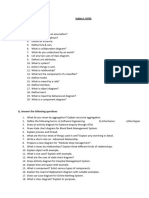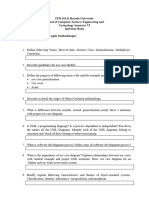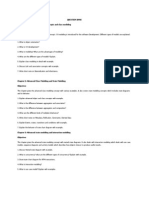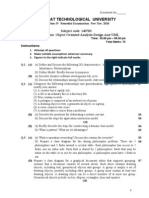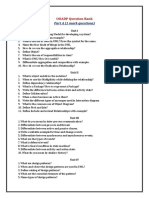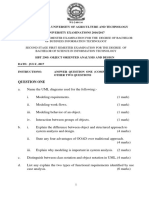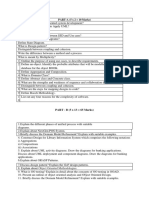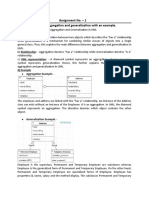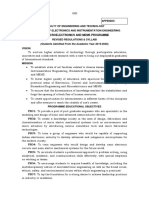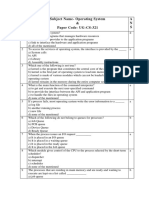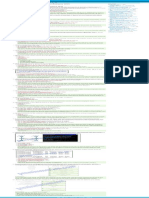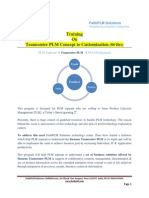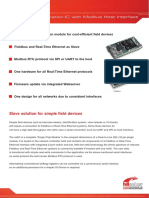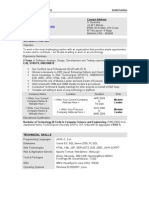SIPNA COLLEGE OF ENGINEERING & TECHNOLOGY, AMRAVATI
Department of Information Technology
• Year/sem: 4th yr /8th sem
• Subject: Object Oriented Analysis and Design
• Syllabus: All Units
• Session: 2023-24 (Even)
Question Bank
UNIT-I
Q.1] Explain the models in OO development. Bring out the relationships among the
models.
Q.2] Explain Object orientation Themes.
Q.3] What is class? What is OMT notation for a class? Discuss the relationships
between class and object.
Q.4] What is object? Discuss the main characteristics of the object with examples
from the real world.
Q.5] Explain the concept of operations and Methods by giving Example.
Q.6] What do you mean by multiplicity of the association? Discuss different types of
multiplicity by giving suitable examples.
Q.7] Define link and association by giving examples and represent them using suitable
notations.
Q.9] With the help of a sample class model explain the following:
1) Values and attributes
2) Operations and methods
3 ) Link, Association, Association end names
4) Bags and sequences
5) Ordering
6) Association Class
7) Qualified Association
Q.10] What is Object-Orientation? Explain four aspect of OO approach.
Q.11] What is generalization/Inheritance? Explain their uses?
Q.12] Explain OCL construct for traversing class model with Example?
Q.13] Consider the classes
Person Car Carloan Company Bank
______________ ______________ ______________ ______________ ______________
name ownerID vehicleID name name
birthdate vehicleID customertype companyID bankID
employer1ID ownertype customerID
employer2ID model accountnumber
employer3ID year bankID
personID interestrate
address currentbalance
Prepare a class diagram without ID’s and using Association and Generalization, try to
assign multiplicities.
Q.14] Explain the three kinds of models that separate a system into distinct view.
Q.15] Explain the OCL expression for managing credit card account class model.
Page 1 of 5
� UNIT-II
Q.1] Explain Advanced objects and class concepts by giving suitable example.
Q.2] What is aggregation? How is it different from association?
Q.3] Distinguish between the following:
1) Association and Aggregation
2) Association and Composition
Q.4] Explain and Give examples of each unary, binary and N-ary associations
from the real world.
Q.5] Explain Abstract and Concrete classes by giving Example?
Q.6] Categories the following relationships into generalization, aggregation,
association, N-ary association. Draw and explain:
1. Country has a capital city.
2. A file is an ordinary file or a directory file.
3. File contains records.
4. A person uses a computer language on a project.
Q.7] What is Event ? Describe different types of events.
Q.8] What is state diagram ? Explain state diagram behavior with suitable
example.
Q.9] Explain the following :
i) Aggregation versus association.
ii) Aggregation versus composition.
Q.10] What is N-ary association ? Discuss the criteria for designing N-ary
Association.
Q.11] What are the main components of state diagram? Draw the state diagram for
chess game.
Q.12] Explain the following state diagrams:
1. Activity effect
2. Deactivities
3. Entry and Exit
4. Complete trans
Q.13] Explain Reification with example.
UNIT-III
Q.1] Draw & explain nested state diagram for telephone system.
Q.2] What is state diagram? Draw & explain state diagram of
1. Vending machine
2. Phone line
3. ATM
Q. 3] Places the signal classes into a generalization hierarchy; Pick, character input,
pick, circle pick, box pick, text pick, input signal.
Q.4] What do you mean by concurrency? How are they depicted in the state
diagrams? Explain with example.
Q.5] Consider the figure shown below, remove nested state and construct a flat state
diagram with equivalent semantics.
Page 2 of 5
� Fig. 1
Q. 6] Explain the role of Use Case Model in OOAD? Draw a use diagram for
1. ATM
2. Online Airline Reservation System
3. Physical Bookstore
4. Computer Email System
Q. 7] Prepare a scenarios for the following situation:
Moving a bag of corn, a goose, and a fox across the river in a boat. Only one thing may
be carried in the boat at a time. If the goose is left alone with the corn, the corn will be
eaten. If the goose is left alone with the fox, the goose will be eaten. Prepare two
scenarios one in which something gets eaten and one in which everything is safely
moved across the river.
Q. 8] List & Explain guidelines for use case models, sequence model and activity
model.
Q. 9] What is sequence models? Draw sequence diagram for
1. a session with online stock broker
2. for stock purchase
3. for a stock purchase that fails
Q. 10] What is activity model & how it is differ from traditional flowchart? Explain
with example.
Q. 11] Prepare an activity diagram that elaborates the details of login into email system.
Q.12] Explain the following with the help of proper diagram
1. Use case Relationship
2. Procedural sequence model
3. Special constructs for activity models
Q. 13] A customer decides to upgrade her PC and purchase a DVD player. She begins
by calling the sales department of PC vendor and they tell her to contact customer
support. She than calls customer support and they put her on hold while talking to
engineering. Finally, customer support tells the customer about several supported DVD
options. The customer chooses a DVD and it is shipped by the mail department. The
customer receives the DVD , installs it satisfactorily and then mails her payment to
accounts department.
Construct an activity diagram for this process. Use swimlanes to show the various
interactions.
Q. 14] What do you understand by interaction? How to model interaction in OOAD
using sequence diagram. Explain giving suitable example.
Q. 15] Explain concurrency for state model.
Q.16] Give guidelines for sequence model.
Q.17] Draw and explain activity diagram for stock trade processing.
Page 3 of 5
� Unit-IV
Q. 1] List and describe all the phases of software development using object oriented
Approach.
Q. 2] Explain the steps of system conception.
Q. 3] Distinguish between domain analysis and application analysis.
Q. 4] Draw a problem statement for ATM and prepare the domain Class model.
Q. 5] Distinguish between waterfall and iterative development.
Q. 6] Describe the construction of domain class model with steps.
Q. 7] Explain Domain state model and domain interaction model.
Q. 8] The following are the list of classes. Prepare a list of classes that should be
eliminated for any of the reasons. Give a reason for each elimination.
Scheduling, software, meeting, user, chairperson, software, meeting entry, schedule,
attendee, scheduler, room, time, everyone, attendance, acceptance status, meeting
notice, invitation, meeting information, invitee, notice.
Q.9] Prepare a problem statement for an Automated Teller Machine (ATM).
Q.10] What is association in a Domain class model? Specify the Semantics of
association.
Q.11] Explain software development stages each with a distinct purpose, input and
output.
Q.12] What are the steps performed in constructing a domain state model.
Q. 13] Describe the ATM class model with right attributes.
Q.14] Explain different steps in software life cycle.
Q.15] How to prepare problem statement?
Unit-V
Q.1] Discuss the steps for choosing a software control strategy.
Q.2] Explain in brief:
i) Libraries.
ii) Frame works.
iii) Patterns.
Q.3] Describe the steps in designing application class model.
Q.4] Draw a state diagram for transaction controller and prepare its scenario.
Q.5] Explain the management of data storage in system design
Q.6] Explain layers and partition with example.
Q.7] Draw and explain state diagram for session controller and transaction controller.
Q.8] Explain application interaction model in detail.
Q.9] Why software architecture is so important in system design? Enlist and briefly
explain different architectural styles.
Q.10] Explain following concepts with reference to system design:
i) Reusable components and their use
ii) Methods of breaking system into subsystems
iii) Management of data storage
Q.11] Explain following design concept:
1. Estimating Performance
2. Identifying concurrency
3. Handling global Resource
4. Handling boundary condition
Page 4 of 5
� Unit-VI
Q.1] Explain in brief Refactoring.
Q.2] Write an algorithm to draw the following figures on a graphics terminal. The
figures are not filled. Assume pixel based graphics. State any assumptions that you
make.
i) Circle.
ii) Square.
iii) Rectangle.
Q.3] What are the steps to be considered for designing Algorithm ?
Q.4] Explain the tasks in design optimization.
Q.5] What do you mean by bridging the gap and refactoring in a class design?
Q.6] Explain different steps for organizing a class design.
Q.7] Explain different tasks in design optimization.
Q.8] Explain in brief:
i) Information hiding
ii) Coherence of entities
Q.9] Why class design is prepared? Explain following concepts with respect to class
design:
i) Bridging gap
ii) Designing algorithms
iii) Design optimization
iv) Refactoring
v) Reification
vi) Inheritance
Q.10] Mention the importance of analysis and design stages in software development
process. Differentiate following with respect to analysis and design stages:
i) Domain analysis vs. Application analysis
ii) System design vs. Class design
Page 5 of 5







